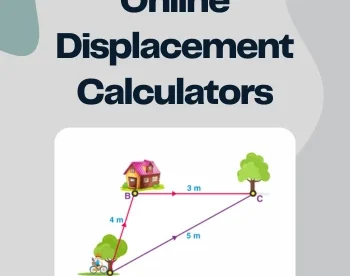12 Best Free Websites for MX Lookup Online
Here is a list of the best free websites for MX Lookup online. MX record is short for Mail Exchange record. It is a resource record in the Domain Name System (DNS). There are many email hosting services and a domain can use one or multiple email hosts for load balancing and redundancy. An MX record contains the email server address for that domain. This record redirects the emails to the configured server for successful delivery. If a domain does not have an MX record configured, it won’t receive any email. Any email sent to that domain address won’t be able to locate the host and thus gets undelivered.
MX Lookup checks the MX record of a domain. When you test a domain, it shows whether the domain has an MX record configured or not. If the domain has MX record(s), it confirms that by listing the configured server. In the case of multiple MX records, it lists the configured email servers by priority set by the domain admin. This post covers 12 free websites where you can look up MX records online. You can go through the post to check these out in detail.
My Favorite Website for MX Lookup Online
DNSChecker.org is my favorite MX Lookup website on this list. It is quite simple to use for anyone. It neatly lists the hostname(s) and IP(s) for anyone to understand and marks their location on the map. This website can perform various other lookups and comes with a couple of unique features to run custom checks in a time-efficient manner.
You can check out our lists of the best free Online Bulk Reverse DNS Lookup Websites, Reverse NSlookup Online Websites, and Online SPF Record Checker Websites.
DNSChecker.org

DNSChecker.org is one of the best websites for all DNS-related lookups. It supports MX, A, AAAA, CNAME, NS, PTR, SRV, SOA, TXT, CAA, DS, and DNSKEY. You can simply provide a domain URL and pick the lookup that you want to perform. In the case of MX lookup, the checks return with the hostnames associated with the domain. It also lists the IP addresses and marks the location of each host on a world map. This tool has two unique features. The first one is that it allows you to add a custom DNS server in the check. And the second is an auto-refresh feature. When used, it automatically refreshes the results after a user-selected time interval.
How to check the MX record on DNSChecker.org?
- Go to the DNSChecker.org homepage; use the link given below for the same.
- Enter the domain into the tool there and pick the MX lookup option from the dropbox next to the domain.
- Then click the Search button to get the results.
Highlights:
- This tool checks MX records and lists the hostnames.
- It lists the server address by server location.
- Plots the server locations on the map.
- Option to add a custom DNS server in the check.
- Auto-refresh option to update the results every 20 seconds or so.
WhatsMyDNS.net
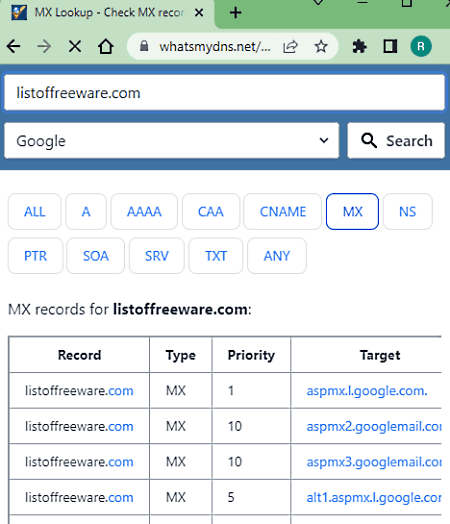
WhatsMyDNS.net is a free website to look up MX records online. You can use this website for various types of DNS queries. The interface is the same for all. To perform an MX lookup, you simply have to select the MX option and pick the hostname to check. In the results, it lists the MX records of the given websites where it shows the host server with their priority and TTL. You can pick a hostname of your choice to check the MX record priority order for the select email host.
How to check the MX record on WhatsMyDNS.net?
- Head over to the WhatsMyDNS.net homepage; use the link given below for the same.
- Enter the domain into the tool there and pick a hostname for the check.
- Then select the MX lookup option from below and click the Search button to get the results.
Highlights:
- This tool checks MX records and lists the hostnames in tabular form.
- It shows Domain, Record Type, Priority, Value(server), and TTL.
- Option to cheks MX for Google, Cloudflare, OpenDNS, Quad9, and Yandex.
- It shows the priority of each hostname alongside the target server and TTL.
- Global-View: It lists all the servers by location and includes IPs.
- Plots the server locations on the map.
DNSLookup.online

DNSLookup.online is a free website where you can look up MX records online. The MX lookup tool here can be used for specific server types and hostname. It comes with a set of pre-defined server types and commonly used servers from Google, Yandex, Cloudflare, OpenDNS, Quad9, HiNet, and more. You can make a selection and then insert the domain you want to check. This lists the hostname configured for that domain in a table. Along with the hostnames, it also includes other parameters such as Preference, Class, TTL, etc.
How to check the MX record on DNSLookup.online?
- Use the link given below leading to this DNS Lookup tool.
- Pick the DNS Server and Hostname of your choice from the given option.
- Enter the domain that you want to check and click the MX Lookup button to get the results.
Highlights:
- This tool checks MX records and lists the hostnames in tabular form.
- It shows Domain, Record Type, Preference, Exchange (server), Class, and TTL.
- Option to cheks MX for Google, Cloudflare, OpenDNS, Quad9, Yandex, etc.
KDMARC.com
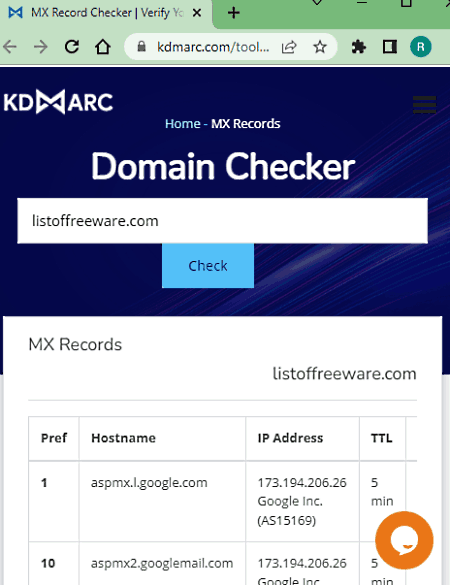
KDMARC.com is another free website that comes with an MX Lookup tool. This is a simple tool to query DNS servers and get instant results. It fetches the hostname, Preference, IP address, TTL, and Description. As soon as you submit the input, it shows all these details in a table. This way, you can quickly validate the MX records of a domain within seconds.
How to check the MX record on KDMARC.com?
- Follow the link given below to open this DNS Lookup tool.
- Add the domain that you want to check.
- Then click the Check button to get the results.
Highlights:
- This tool checks MX records and lists the hostnames in tabular form.
- It shows Domain, Record Type, Hostname, IP Address, and TTL
NSLookup.io
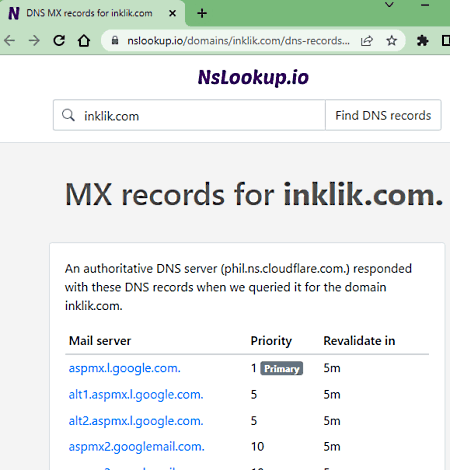
NSLookup.io is a free website for DNS lookups. This website performs a complete DNS check on a given domain. This includes A, AAAA, CNAME, TXT, NS, MX, SOA, and other checks. When you perform a DNS query, it sorts the results by the DNS hostnames such as Cloudflare DNS, Google DNS, OpenDNS, etc. Then you can expand a DNS host of your choice and explore the MX records. The MX records here include Mail exchanger server, priority, and TTL.
How to check the MX record on NSLookup.io?
- Follow the link given below to open this tool in your browser.
- Enter the domain that you want to check.
- Then click the Find DNS Records to get the results.
Highlights:
- This tool checks MX records and sorts those by servers.
- The data includes Mail Exchanger along with their priority and TTL.
IPocation.io
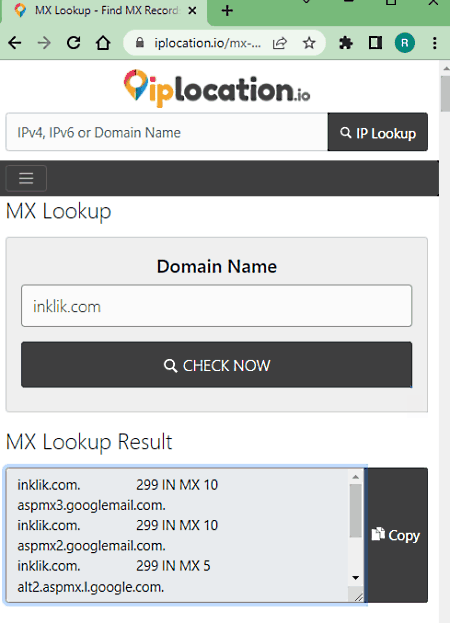
IPocation.io is a free website with a collection of internet and DNS tools. It has a simple MX Lookup tool to perform the MX Record Lookup. This tool checks the MX Record to find the internal & external mail servers for a particular domain. It gives the output in plain text covering the domain, priority, type, and hostname.
How to check the MX record on IPocation.io?
- Use the link given below to open this DNS Lookup tool.
- Add the domain that you want to check.
- Then click the Check Now button to get the results.
Highlights:
- This tool checks MX records and lists the hostnames in tabular form.
- It shows Record Type, Hostname, Priority, etc.
- Option to copy the results in 1-click.
IPVoid.com
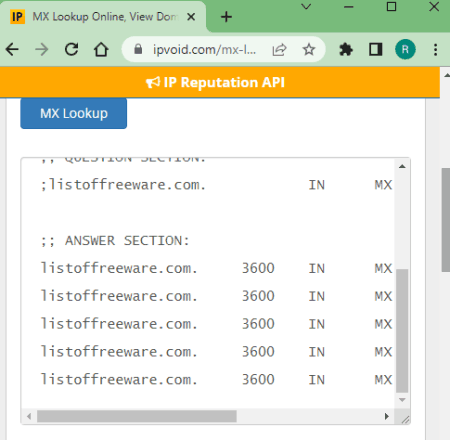
IPVoid.com is another free website with an MX lookup tool to find the MX records of a domain. You can simply add the domain that you want to check and get the MX record data. The output is plain text but well-formatted. It shows all the hostnames/servers along with priority and more. From there, you can copy the record and save it using a text editor or spreadsheet.
How to check the MX record on IPVoid.com?
- Go to this MX Lookup tool using the link given below.
- Add the domain that you want to check.
- Then click the MX Lookup button to get the results.
Highlights:
- This tool checks MX records and lists the hostnames in tabular form.
- It shows Record Type, Hostname, Priority, etc.
DNSQueries.com
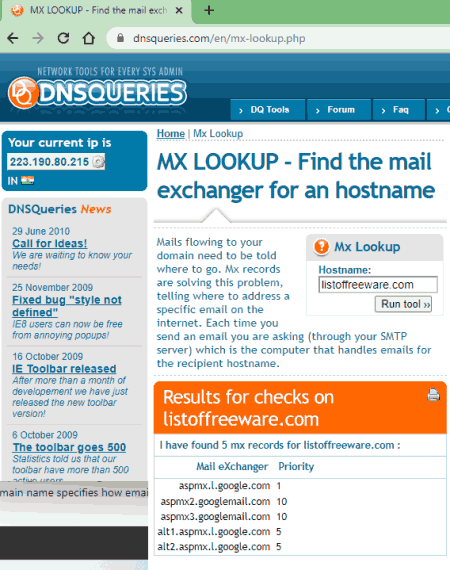
DNSQueries.com is a free website where you can perform various types of DNS queries. It has an MX Lookup tool that you can use to check the Mail eXchanger used by a domain. The process is simple and straightforward. All you have to do is enter the domain, run the tool and get the result. The results start with the number of records it finds followed by Mail Exchanger along with their priority of those records. If you want to save the results, you can do that using the print option alongside.
How to check the MX record on DNSQueries.com?
- Follow the link given below to open this tool in your browser.
- Enter the domain that you want to check.
- Then click the Run Tool button to get the results.
Highlights:
- This tool checks MX records and lists the hostnames.
- The data includes Mail Exchanger along with their priority.
- Option to print the output for safekeeping.
MXToolBox.com

MXToolBox.com is a popular website for DNS queries and other internet tools. You can check the MX record of a domain on this website. The MX Lookup here lists MX records for a domain in priority order. It includes the hostname, priority, IP address, and TTL. From the results, you can run the Blacklist Check and SMTP Test on each listed hostname.
How to check the MX record on MXToolBox.com?
- Go to the MXToolBox homepage; use the link given below for the same.
- Enter the domain into the tool there and pick the MX Lookup option from the dropdown to get the results.
Highlights:
- This tool checks MX records and lists the hostnames.
- It lists the server address by preference.
- The results include IP addresses, priority, and TTL along with the hostnames.
Online-Domain-Tools.com
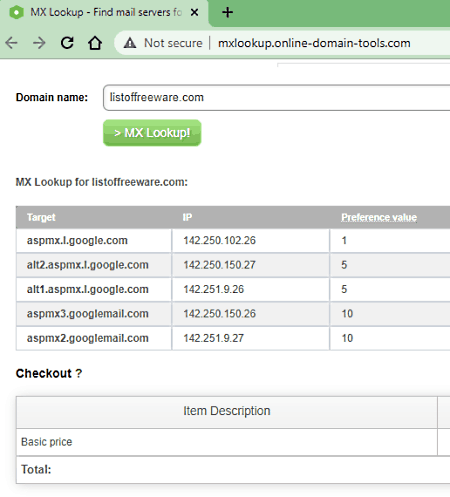
Online-Domain-Tools.com offers a free online MX Lookup tool. This is a simple tool where you can find out the mail exchanger servers used by a domain. The output lists the hostnames/servers in a table covering their IP addresses, Preference value, and TTL. That’s pretty much all you get with this tool. But it does have an option to share a run-link to the lookup. Opening that link starts the same check and loads the results.
How to check the MX record on Online-Domain-Tools.com?
- Go to this MX Lookup tool using the link given below.
- Add the domain that you want to check.
- Then click the MX Lookup button to get the results.
Highlights:
- This tool checks MX records and lists the hostnames in tabular form.
- It shows hostnames/servers, IP addresses, Priority, and TTL.
- Option to share a run-link of the lookup.
iSOS.com
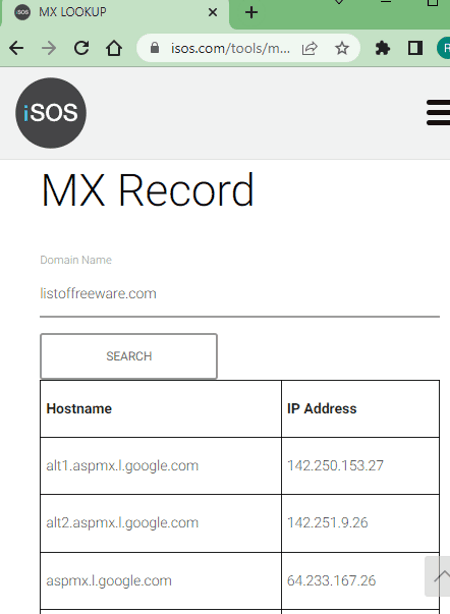
iSOS.com is a free website with MX Lookup online. This is a very simple tool that checks the MX records of a given website. You can simply add the domain and then run the tool to get the output. The results include hostnames along with their IP addresses.
How to check the MX record on iSOS.com?
- Open this tool in your browser using the link given below.
- Add the domain that you want to check.
- Then click the Search button to get the results.
Highlights:
- This tool checks MX records and lists the hostnames in tabular form.
- It covers the hostnames and their IP addresses.
WebsitePulse.com
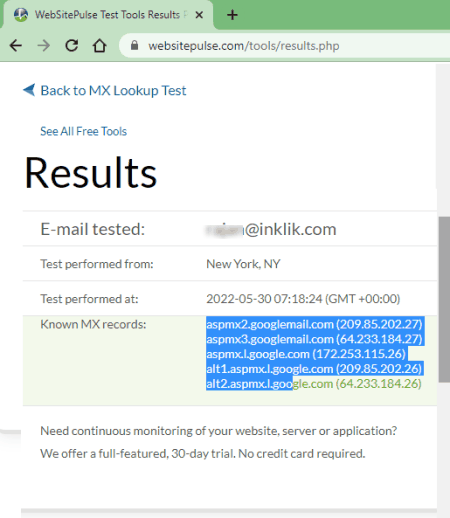
WebsitePulse.com is yet another website to run the MX Lookup test online. The MX lookup test performs an MX record lookup for a specific domain, which returns a list with servers responsible for delivering the e-mail to that domain and their priority relative to each other. The test results display the hostnames and IP addresses of the Mail Exchange Servers.
How to check the MX record on WebsitePulse.com?
- Go to this MX Lookup tool using the link given below.
- Add the domain that you want to check.
- Then click the Test Now button to get the results.
Highlights:
- This tool checks MX records and lists the hostnames in tabular form.
- The result includes the hostnames with IP addresses.
- Option to pick a monitoring location from the US, Europe, and Australia.
About Us
We are the team behind some of the most popular tech blogs, like: I LoveFree Software and Windows 8 Freeware.
More About UsArchives
- May 2024
- April 2024
- March 2024
- February 2024
- January 2024
- December 2023
- November 2023
- October 2023
- September 2023
- August 2023
- July 2023
- June 2023
- May 2023
- April 2023
- March 2023
- February 2023
- January 2023
- December 2022
- November 2022
- October 2022
- September 2022
- August 2022
- July 2022
- June 2022
- May 2022
- April 2022
- March 2022
- February 2022
- January 2022
- December 2021
- November 2021
- October 2021
- September 2021
- August 2021
- July 2021
- June 2021
- May 2021
- April 2021
- March 2021
- February 2021
- January 2021
- December 2020
- November 2020
- October 2020
- September 2020
- August 2020
- July 2020
- June 2020
- May 2020
- April 2020
- March 2020
- February 2020
- January 2020
- December 2019
- November 2019
- October 2019
- September 2019
- August 2019
- July 2019
- June 2019
- May 2019
- April 2019
- March 2019
- February 2019
- January 2019
- December 2018
- November 2018
- October 2018
- September 2018
- August 2018
- July 2018
- June 2018
- May 2018
- April 2018
- March 2018
- February 2018
- January 2018
- December 2017
- November 2017
- October 2017
- September 2017
- August 2017
- July 2017
- June 2017
- May 2017
- April 2017
- March 2017
- February 2017
- January 2017
- December 2016
- November 2016
- October 2016
- September 2016
- August 2016
- July 2016
- June 2016
- May 2016
- April 2016
- March 2016
- February 2016
- January 2016
- December 2015
- November 2015
- October 2015
- September 2015
- August 2015
- July 2015
- June 2015
- May 2015
- April 2015
- March 2015
- February 2015
- January 2015
- December 2014
- November 2014
- October 2014
- September 2014
- August 2014
- July 2014
- June 2014
- May 2014
- April 2014
- March 2014

